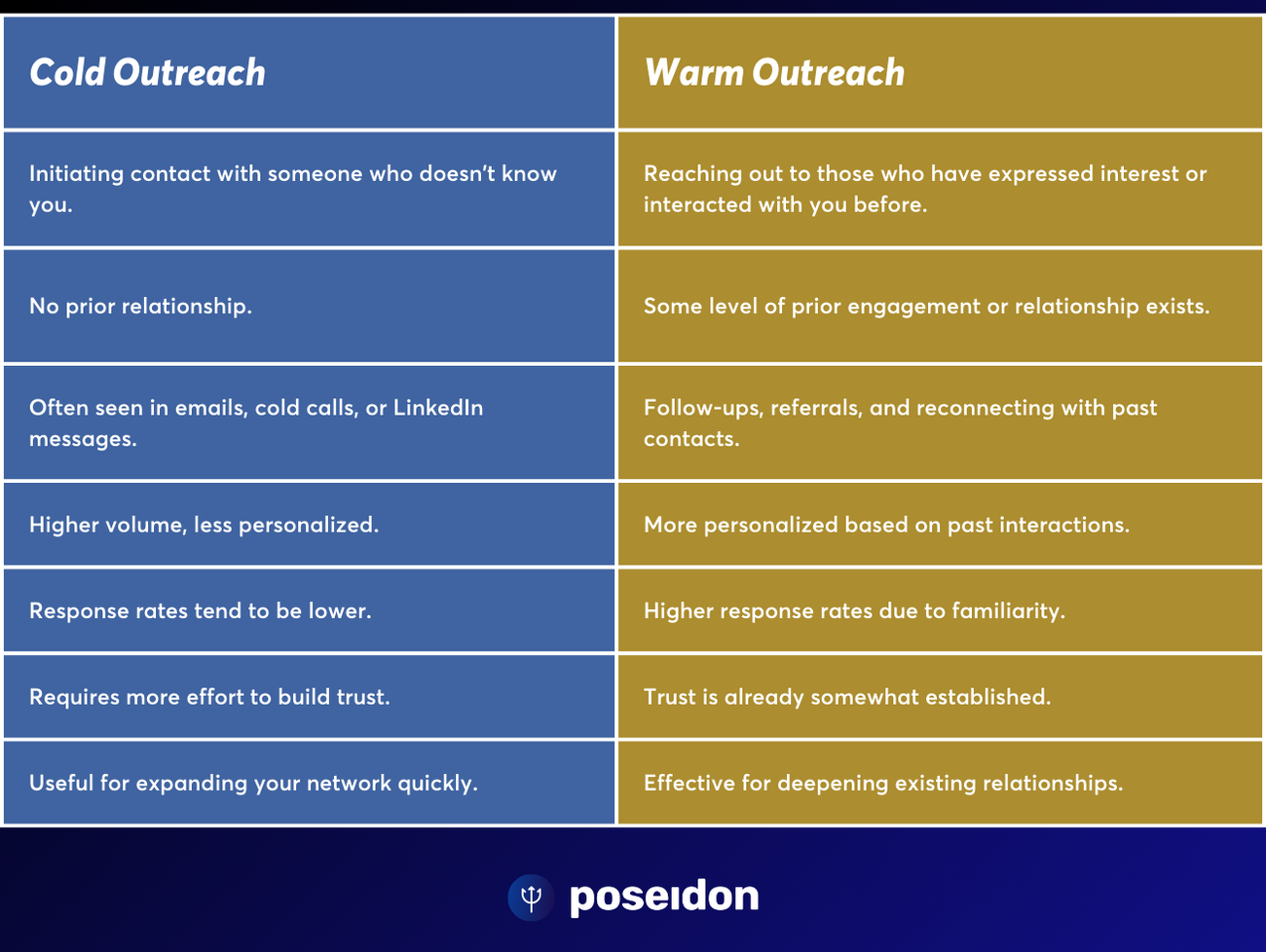Reaching out to strangers can feel hard.
One fact is clear: cold outreach works when done right. This article will show you the best practices and strategies for effective cold outreach.
Keep reading to learn how!
What is Cold Outreach?
Cold outreach is reaching out to potential customers or clients who have had no prior contact with your business. It's crucial to understand the difference between cold and warm outreach for effective communication and conversion.
Definition and Importance
Cold outreach is contacting someone for the first time without them expecting it. It's like knocking on a stranger's door to introduce yourself and what you offer. This method is key in business development, sales prospecting, and lead generation.
By reaching out cold, companies find new customers, make more sales, and grow their network.
Cold outreach turns strangers into friends and friends into customers.
It differs from warm outreach because the person does not know you yet. In warm outreach, they have heard of you or interacted with your company before. Cold outreach helps businesses tap into new markets and opportunities that they wouldn't have found otherwise.
Cold Outreach vs. Warm Outreach
Understanding the difference between cold outreach and warm outreach is key in crafting your communication strategy. Here's a simplified breakdown in a table format to give you a clearer picture.

This table aims to clarify the distinct paths cold and warm outreach entail. Each has its place in a comprehensive communication strategy.
Core Strategies for Effective Cold Outreach
Make your outreach personal, address the prospect's needs and use multiple channels. Tailor strategies for different sectors like marketing, sales, and recruiting.
Personalization Techniques
Personalization is key in cold outreach. It shows you know who you're talking to and what they need.
- Use the recipient's name. This makes your email feel personal right away.
- Mention their company name. It shows you've done your homework.
- Refer to a recent achievement of theirs. This could be an award or a successful project they've shared online.
- Suggest how your service or product meets their specific needs. Be clear on how it can help them.
- Share a quick success story related to their industry. This shows your solution works for similar challenges.
- Use language that matches their industry's tone. If they're formal, be formal; if they're more casual, match that style.
- Include a question about their current challenge related to your offer. This invites them to engage with you.
- Personalize the call-to-action (CTA sales rep can effectively use cold email to connect with potential clients.). Instead of a generic "Click here," say something like "See how we helped [similar company] succeed."
- End with a signature that includes your photo or social media links. This adds a human touch to the message.
- Follow up with personalized content based on their response or lack thereof, showing persistence without being pushy.
Understanding and Addressing Prospect Needs
After personalizing your outreach, it's crucial to understand and address the specific needs of your prospects. This ensures that your communications resonate with them on a deeper level. Here are effective ways to do this:
- Research and analyze your prospects' pain points and challenges.
- Tailor your messaging to demonstrate how your product or service can solve their specific problems.
- Use case studies or testimonials to show real-life examples of how you've helped similar businesses in their industry.
- Ask targeted questions to uncover their unique requirements and goals.
- Provide relevant content or resources that directly speak to their needs, positioning yourself as a valuable partner.
By focusing on these strategies, you can make sure that your cold outreach efforts are more personalized and impactful, ultimately leading to higher engagement and conversions.
Multichannel Approach
A multichannel approach involves reaching out to prospects through different channels like email, social media, and direct mail. Using multiple channels increases the chances of connecting with potential clients as it meets them where they are.
For example, a study found that using three or more channels in a campaign significantly increased responses compared to single-channel campaigns (Demand Gen Report, 2019). This shows the importance of diversifying outreach efforts across various platforms.
By leveraging diverse channels such as email, LinkedIn messaging, and phone calls concurrently, you can engage with prospects on multiple fronts and increase the likelihood of getting their attention.
Adopting a multichannel strategy has proven effective in engaging prospects throughout their buyer's journey. According to research by Harvard Business Review Analytic Services (2020), organizations utilizing multichannel strategies observed significant boosts in customer engagement levels.
Moreover, having an omnichannel customer engagement strategy can lead to an average 89% retention rate compared to only 33% for companies without one (Invesp). Therefore, integrating various touchpoints enables businesses to reinforce their message consistently while accommodating customers' preferences for how they want to interact with brands.
Specific Strategies by Sector
Customizing your approach to meet the distinct requirements of various sectors can greatly influence outreach success. Grasping the particular strategies for marketing, sales, and recruiting will offer valuable insights and tactics for effectively maneuvering through each sector.
Marketing
Marketing plays a crucial role in cold outreach, particularly in crafting messages that resonate with your target audience. The marketing sector depends on personalized content and strategies to engage prospects effectively.
Email outreach campaigns often benefit from the expertise of marketing professionals who understand customer acquisition and lead generation techniques. They leverage their knowledge to create compelling cold email templates and employ multichannel approaches to increase engagement rates.
Moreover, A/B testing is used to measure the effectiveness of different marketing outreach tactics, enabling continuous improvement in communication strategies.
Sales
Sales teams often rely on cold outreach strategies can be enhanced by utilizing effective outreach email techniques. to generate leads and boost revenue. Effective sales outreach involves personalization techniques, understanding prospect needs, and a multichannel approach using platforms like email, LinkedIn, and even cold calling.
Crafting the perfect cold email subject line can significantly impact open rates and engagement with prospects. Adopting automation tools can streamline outreach processes but should be balanced with manual efforts for a human touch.
Measuring key performance indicators (KPIs) and continuous improvement practices are essential for optimizing sales outreach strategies.
Recruiting
Recruiting plays a vital role in cold outreach strategies, particularly in areas such as marketing and sales. Understanding the distinct requirements and anticipations of potential candidates is crucial in the realm of recruiting.
Adapting your approach to meet these needs will significantly improve the efficiency of your outreach endeavors. Using customized messaging templates on platforms like LinkedIn can greatly enhance B2B engagement with potential hires.
Keep in mind that assessing key performance indicators (KPIs) like response rates and conversion rates is essential for refining recruiting outreach campaigns.
Now, let's explore specific tactics for cold email outreach.
Cold Email Outreach
Craft the Perfect Cold Email to get your message across effectively and encourage recipients to take action. Ready to learn more?
How to Write the Ideal Cold Email
Crafting the perfect cold email can significantly enhance your outreach success. Here are the essential components of crafting an effective cold email:
- Subject Line: Utilize a brief, attention-grabbing subject line that entices the recipient to open the email. Integrate personalization and relevance to increase open rates.
- Personalization: Customize each email to the recipient by addressing them by name and referencing specific details about their company or industry.
- Clear Value Proposition: Clearly convey the value you offer to the recipient and how it addresses their needs or challenges.
- Conciseness: Keep the email brief and focused, respecting the recipient's time. Avoid lengthy paragraphs and unnecessary information.
- Call to Action: Include a clear A strong call to action is essential in your outreach email to encourage responses. that prompts the recipient to take the next step, whether it's scheduling a meeting, visiting your website, or responding to your email.
- Professional Formatting: Ensure the email is well-formatted with proper spacing, grammar, and punctuation for easy readability.
- Follow-Up Plan: Develop a follow-up plan for recipients who don't respond initially, including a series of follow-up emails with different messaging.
- A/B Testing: Experiment with different elements of your cold email, such as subject lines, content, or calls to action, to analyze which approach yields better results.
Remember that crafting compelling cold emails necessitates continuous refinement based on recipient responses and industry trends.
Best Practices for Cold Email Subject Lines
Crafting effective subject lines is crucial for engaging recipients in cold email outreach. The right subject line can make or break the success of your campaign. Here are some best practices to consider when creating your cold email subject lines:
- Keep it concise and specific to pique interest.
- Use personalization by including the recipient's name or company.
- Avoid spam triggers such as excessive punctuation or all caps.
- Incorporate a sense of urgency or benefit to entice the recipient to open.
- Test different variations to see what resonates best with your audience.
- Leverage relevant keywords to align with the recipient's interests and needs.
- Consider using questions or intriguing statements to spark curiosity.
- Tailor subject lines to match the content of the email for consistency and relevance.
By implementing these strategies, you can enhance the effectiveness of your cold email subject lines and improve engagement with your prospects.
Legal Considerations of Cold Emailing
Cold emailing involves legal considerations. The CAN-SPAM Act establishes guidelines for commercial emails, including the necessity of a valid physical postal address in each email and the option for recipients to unsubscribe.
Moreover, if sending emails to individuals in the European Union, one must adhere to the GDPR, which mandates obtaining prior consent before sending commercial emails and providing transparent information on data usage.
Observing these laws prevents legal issues. Disregarding them results in significant fines. For instance, under CAN-SPAM, penalties can amount to up to $41,484 per separate email violation.
Similarly, failure to comply with GDPR can result in fines of up to €20 million or 4% of a company's global annual revenue for the previous financial year – whichever is higher.
LinkedIn Strategies for Cold Outreach
Optimize Profile for Outreach
To optimize your profile for outreach on LinkedIn, follow these steps:
- Use a professional headshot that showcases your personality and aligns with your brand image.
- Craft a compelling headline that clearly communicates your expertise and the value you offer.
- Write a concise yet captivating summary that highlights your unique selling points and resonates with your target audience.
- Showcase your experience, skills, and accomplishments through rich media content such as presentations, videos, or articles.
- Build a robust network by connecting with relevant professionals in your industry and engaging with their content.
- Actively participate in groups related to your field to establish yourself as a thought leader and expand your reach.
- Seek recommendations from colleagues, clients, or supervisors to strengthen social proof and credibility.
These strategies will enhance your profile's visibility and attractiveness for effective outreach on LinkedIn.
Personalized Messaging Templates
Using personalized messaging templates in cold outreach can significantly improve response rates and engagement. Tailoring your messages to the specific needs and pain points of your prospects can make a big difference. Below are some effective techniques for crafting personalized messaging templates:
- Research your prospects thoroughly to understand their business challenges, goals, and industry trends.
- Use this information to tailor your messaging by highlighting how your product or service can directly address their specific needs.
- Incorporate personalization tokens in your emails to dynamically insert recipient-specific details, such as name, company, or recent activities.
- Leverage case studies or testimonials that resonate with the prospect's industry or pain points.
- Align the messaging with the prospect’s position in the sales funnel, ensuring that each message is relevant and valuable to their current stage.
These personalized messaging templates can create a more impactful initial connection with potential leads and improve the overall effectiveness of your cold outreach efforts.
LinkedIn for B2B Engagement
LinkedIn is a powerful platform for connecting with businesses. When optimizing your LinkedIn profile for B2B engagement, it's crucial to incorporate relevant keywords to enhance visibility and attract the right audience.
Engage with potential clients or partners through personalized messages that address their specific needs.
To enhance B2B engagement on LinkedIn, consider joining industry-relevant groups and participating in discussions. Share valuable content like industry reports or insightful articles that demonstrate your expertise.
Utilize LinkedIn's advanced search feature to find decision-makers within target companies and reach out to them directly with tailored messages highlighting how your product or service can benefit their business.
By using these strategies, you'll be able to reveal the secrets of B2B engagement on LinkedIn and expand your professional network effectively.
Automation in Cold Outreach
Benefits and Risks
While automation in cold outreach offers numerous benefits, it's important to be aware of potential drawbacks. This includes the risk of impersonal communication, which may lead to decreased response rates and harm relationships with prospects.
Relying too heavily on automation might also mean missing out on valuable insights that come from manual interaction. Moreover, improper use of automation could result in non-compliance with data protection regulations such as GDPR or CAN-SPAM Act.
Achieving a balance between automated efficiency and personalized human interaction is essential for effective cold outreach campaigns while ensuring compliance with relevant regulations.
Comparing Manual vs. Automated Outreach
Manual and automated outreach have different benefits. See how they stack up.

Tools and Platforms for Automation
In the previous section, we discussed the comparison between manual and automated outreach. Now, let's explore the tools and platforms available for automation to streamline your cold outreach efforts.
- Outreach Automation Platforms: Outreach Tools like Poseidon provide features to automate email sequencing and prospect engagement, making it easier to manage outreach campaigns at scale.
- CRM Systems: Customer Relationship Management (CRM) systems such as Salesforce and Zoho offer automation capabilities to track interactions with prospects, schedule follow-ups, and manage leads effectively.
- Email Marketing Automation Software: Platforms like Mailchimp, Constant Contact, and Klaviyo allow for setting up automated email sequences based on prospect behavior or specific triggers.
- Social Media Management Tools: Utilize tools like Hootsuite or Buffer to schedule and automate social media posts for consistent B2B engagement across multiple channels.
- AI-Powered Chatbots: Implement AI chatbots like Intercom or Drift on your website to engage with visitors in real-time, answer FAQs, and capture lead information automatically.
- Marketing Automation Platforms: Platforms such as Marketo or Pardot enable automated lead nurturing through personalized content delivery based on prospect interests and behaviors.
- Data Enrichment Tools can help you gather accurate email addresses for your outreach messages.: Leverage data enrichment tools like Clearbit or ZoomInfo to automatically enrich prospect data for more targeted and personalized outreach efforts.
- Analytics & Reporting Software: Use analytics platforms such as Google Analytics or Tableau to automate the tracking of key performance indicators (KPIs) for your outreach campaigns.
Measure Your Outreach
Measuring and optimizing outreach involves tracking key performance indicators, testing different strategies, and continuously improving your approach. Learn more about maximizing the effectiveness of your cold outreach.
Key Performance Indicators (KPIs)
Key Performance Indicators (KPIs) are essential metrics for assessing the effectiveness of cold outreach strategies. These metrics help measure the success and impact of outreach efforts, providing valuable insights for optimization and improvement.
- Open Rate: This KPI measures the percentage of recipients who open your cold emails, indicating initial engagement with your outreach campaign.
- Response Rate: The response rate KPI tracks the proportion of recipients who respond to your cold emails, reflecting the effectiveness of your messaging in capturing interest or addressing prospect needs.
- Conversion Rate: This KPI measures the percentage of recipients who take the desired action after engaging with your cold outreach, such as signing up for a demo or making a purchase.
- Click-Through Rate (CTR): The CTR KPI evaluates how many recipients clicked on links within your cold emails, indicating their level of interest in exploring further information or offers.
- Meeting/Call Scheduled Rate: This KPI tracks the percentage of prospects who agree to schedule a meeting or call following initial cold outreach, demonstrating successful progression through the sales funnel.
- Unsubscribe Rate: The unsubscribe rate KPI monitors the percentage of recipients who opt out of further communication from your outreach efforts, providing insights into audience preferences and content relevance.
- Revenue Generated: Tracking the revenue generated from leads acquired through cold outreach provides a direct correlation between your outreach efforts and business outcomes.
- Customer Acquisition Cost (CAC): Calculating the cost associated with acquiring customers through cold outreach helps evaluate the efficiency and sustainability of these acquisition channels.
- Engagement Duration: Assessing how long recipients engage with your content can provide insights into its relevance and effectiveness in capturing attention and sustaining interest.
- Follow-Up Success Rate: Tracking the success rate of follow-up interactions initiated after initial cold outreach helps gauge the impact of persistent engagement on conversion and relationship-building.
These Key Performance Indicators serve as crucial benchmarks for evaluating and optimizing cold outreach campaigns to drive meaningful results and ROI.
A/B Testing Strategies
- Utilize A/B testing to compare different elements of your outreach, such as email subject lines, messaging content, and call-to-action buttons.
- Test one variable at a time to accurately measure its impact on the effectiveness of your cold outreach efforts.
- Implement A/B testing tools like Mailchimp or HubSpot to collect and analyze data on open rates, click-through rates, and overall engagement.
- Measure the results of each test to identify which approach resonates best with your target audience and iterate based on findings.
- Incorporate A/B testing into every aspect of your outreach strategy to continuously refine and optimize your approach for maximum impact.
Continuous Improvement Practices
- Perform regular assessments and analysis of outreach performance metrics such as open rates, response rates, and conversion rates to pinpoint areas for enhancement.
- Introduce A/B testing for different outreach approaches, subject lines, messaging templates, and call-to-action strategies.
- Collect feedback from prospects and clients to comprehend their experience with the outreach process and utilize this insight to enhance strategies.
- Stay abreast of industry trends and best practices in cold outreach to adjust and evolve your approach accordingly.
- Foster a culture of learning and development within the outreach team by sharing successful tactics, discussing challenges, and seeking input for improvement from all members.
These continuous improvement practices are crucial for ensuring that your cold outreach strategies remain effective and relevant in an ever-evolving business landscape.
Advanced Tips and Common Pitfalls
Explore advanced tips for effective cold outreach. Sidestep common outreach mistakes and discover follow-up techniques to further enhance your strategies.
Follow-up Techniques
Effective follow-up techniques are crucial for successful cold outreach. They help maintain engagement and build relationships with prospects, increasing the chances of conversion.
- Timely Follow-ups: Ensure prompt follow-up after initial contact to stay fresh in the prospect’s mind.
- Personalized Messages in your cold outreach email can lead to higher engagement rates.: Tailor follow-up messages based on previous interactions and prospect’s specific needs.
- Persistence: Don’t be discouraged by initial non-responsiveness; follow up multiple times at appropriate intervals.
- Provide Value: Offer something of value in each follow-up, such as relevant content or personalized recommendations.
- Multiple Channels: Utilize various channels like email, phone calls, and social media for diverse follow-up approaches.
- Clear Call to Action: Clearly define the next steps or actions you expect from the prospect in your follow-up communications.
- Listen and Adapt: Pay attention to prospect responses and adapt your approach accordingly for effective follow-ups.
- Professionalism: Maintain a professional tone and demeanor in all follow-up communications to build trust and credibility.
These techniques can significantly boost the effectiveness of your cold outreach efforts and lead to higher conversion rates while nurturing strong business relationships with potential clients or partners.
Avoiding Common Outreach Mistakes
To maximize the effectiveness of your cold outreach efforts and ensure you don't miss out on valuable opportunities, it's crucial to be aware of common mistakes that can hinder your progress. Here are some key missteps to avoid:
- Lack of Personalization: Sending generic, impersonalized messages can turn off potential prospects and diminish your chances of success.
- Overlooking Prospect Needs: Failing to thoroughly understand and address the specific needs and pain points of your prospects can lead to disengagement.
- Ignoring Ethical Considerations: Disregarding ethical boundaries in pursuit of leads can damage your reputation and credibility in the long run.
- Inconsistency in Follow-Up: Neglecting to follow up or following up excessively can alienate potential leads and harm your outreach efforts.
- Relying Solely on Automation: Overreliance on automated tools without human touch can come across as insincere and detached.
- Neglecting Data Analysis: Not analyzing the performance data from your outreach campaigns can prevent you from identifying areas for improvement.
- Failure to Adapt Strategies: Refusing to adapt your strategies based on feedback and results will hinder progress and limit success in the long term.
- Skipping A/B Testing: Neglecting A/B testing deprives you of valuable insights that could significantly improve the effectiveness of your outreach campaigns.
- Not Honoring Legal Regulations: Disregarding legal considerations when conducting cold outreach, such as GDPR compliance, could result in severe penalties.
- Overlooking Continuous Improvement: Failing to continuously refine and optimize your outreach strategies can lead to stagnation and missed opportunities for growth.
Ethical Considerations and Best Practices
Maintaining ethical standards in cold outreach is paramount. Respecting privacy and adhering to anti-spam laws are crucial elements. Always ensure compliance with regulations such as CAN-SPAM Act when conducting cold email campaigns.
Personalization should remain authentic without misleading or exaggerating claims, fostering credibility and trust with prospects. Promptly honor opt-out requests, safeguarding individuals' autonomy and preferences.
At the core of best practices lies honesty and transparency, setting accurate expectations without deceptive tactics while striving for genuine connections. Utilize verified contact lists to avoid unsolicited communication as it reflects negatively on business reputation.
Prioritize building long-term relationships over short-sighted gains, reflecting positively on brand perception and integrity within the industry.
Moving forward into 'Conclusion', let's sum up these strategies for an effective cold outreach approach.
Conclusion
In the realm of cold outreach, personalized strategies and effective communication are crucial. Understanding prospect needs and employing a multichannel approach can enhance your outreach.
Keep in mind to measure performance and continuously improve your techniques for better results. Now, let's explore some frequently asked questions about the effectiveness of cold outreach across various industries.
FAQs
What’s the best way to do LinkedIn outreach?
LinkedIn outreach works best when your outreach message is personalized and brief. Make your cold outreach on LinkedIn engaging right from the subject line to boost response rates.
How can I improve my cold email outreach strategy?
Improve your cold email outreach strategy by personalizing emails, verifying email addresses, and using cold email software. Test different cold email subject lines to see what works best.
What are the benefits of cold outreach?
Cold outreach helps you reach new prospects and scale your efforts. The benefits of cold email outreach include its ability to reach a broad audience efficiently.
Any tips for writing a cold email?
Use simple language, personalize your email body, and ensure your email signature is professional. Effective cold outreach starts with a strong, engaging subject line.
How can I make my cold outreach more effective?
Use cold email automation tools, personalize your messages, and track performance with cold email outreach software to make your cold outreach more effective.
Why verify email addresses in cold email outreach?
Verify email addresses to reduce bounce rates and improve deliverability. Using a cold email tool with email verification features is essential.
What types of cold outreach channels should I use?
Consider LinkedIn outreach, email outreach, and cold calling. Cold outreach is one of the most versatile strategies, so mix and match channels.
Can cold outreach include warm outreach techniques?
Yes, start with cold email outreach and follow up with personalized, warm messages to build relationships.
What role does the email signature play in cold outreach?
Your email signature should include your contact information and help establish credibility in your cold outreach.
How do I overcome objections in cold outreach?
Address objections directly in your outreach message and highlight the benefits of cold outreach. Use tips to help make your message more persuasive.




![Best LinkedIn Sales Strategy In 2025 [+Templates]](https://cdn.sanity.io/images/l79olr63/production/f506b7ad35e15d3d5fcdb46ee807bbda7f5df908-1232x928.webp)
